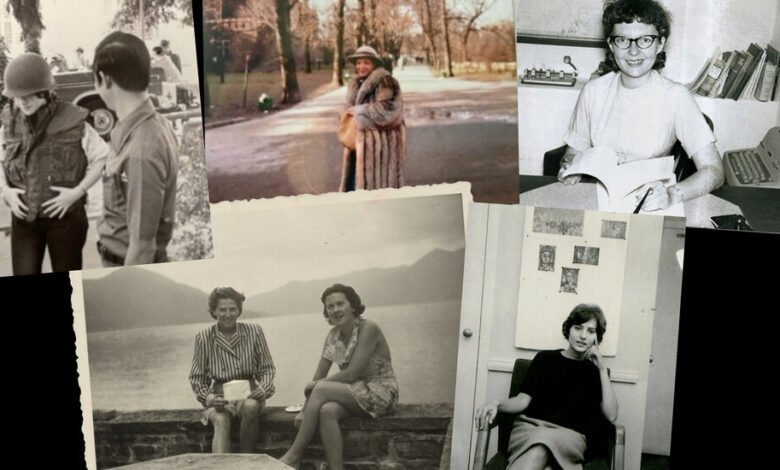Book Review: ‘The Sisterhood,’ by Liza Mundy

THE SISTERHOOD: The Secret History of Women at the CIA, by Liza Mundy
In the 1970s, the keepers of the sensitive information held in the windowless vaults of the Central Intelligence Agency earned themselves a nickname.
Working there was not a glamorous assignment — and so it fell to women. Before the advent of computers, the vault women were tasked with synthesizing information about sources, darting between records and cabinets to compile the requested dossiers.
The resultant step count — and the accompanying penchant for tennis shoes — earned them the derisive moniker “sneaker ladies.” (Secretaries generally felt compelled to wear heels.) But as the journalist Liza Mundy writes in her staggeringly well-researched “The Sisterhood,” this derided basement network powered acts of subterfuge around the world.
From the earliest days of the C.I.A., women were integral to intelligence-gathering. They controlled finance and personnel offices. They served as clerks. They processed cables for men, composed their memos, edited their intelligence reports, rewrote their intelligence reports and married them (a quasi-career track given the critical “housewife cover” that wives provided for snoop husbands).
Yet they were mostly barred from the case officer roles that would have allowed them to function as compensated spies. The prevailing view on the part of the “men of action” who ran the enterprise was that “men worked outdoors, and women worked indoors.”
In the 1950s and 1960s, top C.I.A. officers wooed female recruits with the promise of international exploits — and then steered them toward “a female channel” as reports officers. The dreaded “short course” — a truncated version of certification into which women were funneled to keep them underqualified for case officer status — was substituted like a cruel bait-and-switch. A woman at the top of her class would show up for training at the so-called Farm, only to find herself on the abbreviated track without explanation.
As Mundy shows, some women gamed the system. Their stories are the threads that hold together seven decades of covert action, moral and tactical failures, moments of heart-stopping vindication and several hostage situations. “The Sisterhood” is a crowded — and abbreviation-laden — history; the rare thriller that makes its readers wish for an org chart.
Mundy, who has written four other books, including the similarly sweeping “Code Girls,” delivers suspenseful stories of women like Heidi August, a onetime clerk who went on to spend three decades in the C.I.A. and became one of its first female station chiefs; and Lisa Manfull Harper, who worked menial jobs for a decade before being permitted to complete certification as a sleuth.
We learn of a trio of women who sniffed out the C.I.A. mole Aldrich Ames long before the F.B.I. was onto him. Their radars had gone off when Ames’s wife casually mentioned that she’d ordered treatments for every window in her new house. These women knew how hard it was to zhuzh on a C.I.A. officer’s salary; who, exactly, was paying for the curtains? (The F.B.I. took full credit for the arrest.)
The dossier-compiling of the vault women morphed into the discipline we now know as targeting. In 1986, a new counterterrorist center opened, specializing in tracing and mapping networks — a meticulous approach to man-hunting. With the exception of its male leader, women made up almost all of the staff of what came to be known as Alec Station. Colleagues marveled at its makeup: “a bunch of chicks” chasing clues from their desks.
When that “bunch of chicks” detected that a catastrophic attack on American soil was imminent and tried to warn C.I.A. leaders, most shooed them off. In one of the book’s most devastating chapters, Mundy details how the women of Alec Station — including Barbara Sude, who, a month before 9/11, wrote the famous memo “Bin Laden Determined to Strike in U.S.” — watched the twin towers fall from the lo-fi hookups in their offices.
Mundy concludes “The Sisterhood” with the hunt for Osama bin Laden. In the end, it was the sight of clothes drying on a line that helped confirm to bin Laden’s obsessive pursuers that he and his wives had been hiding out in a guarded compound in Pakistan. Women’s work.
Between the portraits of the female spies who persisted, “The Sisterhood” catalogs their revolts. In 1977, Harritte Thompson brought a complaint to the Equal Employment Opportunity office demonstrating that women made less than men in the same jobs — and that men were promoted faster. When the C.I.A. slow-rolled the issue, she filed a lawsuit and won. In 1994, Janine Brookner filed a federal sexual discrimination lawsuit, which the agency settled. Brookner’s case was tied up with a much larger class-action lawsuit, involving over 200 officers alleging an endemic culture of sexual discrimination, that was not settled until 1995. The fallout, as some of the trailblazers anticipated, was pervasive retaliation for having taken part. Mundy quotes a male case officer, who sat in meetings where women who’d participated in the suit were shut out of prestigious assignments. “It’s not an organization that takes this type of dissent well,” he said. “They were punished,” Harper told Mundy. “Nobody wanted them.”
With its emphasis on women-led reforms and incursions, “The Sisterhood” can breeze past some of the C.I.A.’s most alarming misdeeds — or, by implication, chalk them up to the relative absence of women. In an author’s note, Mundy insists that she does not think women “are better or more virtuous or upstanding” than men, but she does aim to show the particular skills that they can bring to an espionage operation. She is often persuasive, but her narrative of progress can feel disorienting amid incidents of bogus intelligence and international coups.
She is clear on this: For men and women alike, spycraft has often required a certain moral flexibility. Mundy recounts how during the Vietnam War, a case officer named Sue McCloud was assigned to infiltrate international festivals where students were thought to be susceptible to communist thinking. “Given that the Soviets were doing the same thing, McCloud thought the effort made sense,” recounts Mundy.
Later, Mundy tells of Alfreda Bikowsky, a C.I.A. officer who landed at Alec Station, who has not only made no apologies for the use of “enhanced interrogation” tactics like waterboarding, but who, Mundy adds, proved essential in “shaping the strategy used to defend them.”
In November 1985, Heidi August was serving as a C.I.A. station chief in the Mediterranean region when EgyptAir Flight 648 was hijacked. The incident became a massacre, with several passengers shot by terrorists and dozens more later killed in the resulting raid on the aircraft. Mundy doesn’t sugarcoat it, but she does foreground details it would be hard to imagine in more conventional records of the agency. She notes that August, in Malta and still undercover as U.S. consul, was helpless. She was seated at a makeshift command center with a representative of the Palestine Liberation Organization when she was granted a telephone call; she spoke to her secretary in pig Latin. “Spycraft called upon unexpected talents,” Mundy writes. “You never knew what qualities, what tricks learned in girlhood, you would need.”
THE SISTERHOOD: The Secret History of Women at the CIA | By Liza Mundy | Crown | 419 pp. | $32.50





